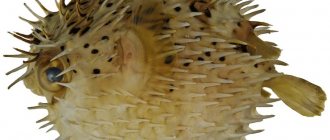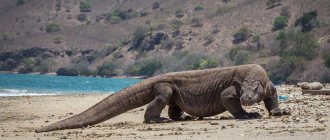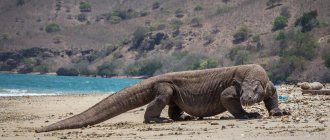There is an idea of dolphins as kind animals that make contact with humans. In children's books they are depicted with a sweet smile; from stories and films about sea animals, we know cases when dolphins saved a person in order to communicate with them and watch a show at dolphinariums. But this is a one-sided idea of dolphins - among them there are species that are truly good-natured and not dangerous to others, but there are also those that are potentially dangerous to humans. The animal world, and in particular the world of dolphins, is fraught with many unknown and interesting things.
Description
Lat.
Inia geoffrensis This is the largest of the river dolphins. The body length of an adult male reaches 255 cm, weight - up to 207 kg. The length of the female is up to 225 cm, and body weight is 153 kg. This species has the strongest sexual dimorphism of all river dolphins. Males are 16% longer and can be 55% heavier than females. The body is powerful and heavy, but at the same time very flexible. The structure of the cervical vertebrae allows you to rotate your head in all directions.
| Order | Suborder | Family | Genus | Cetaceans | Toothed whales | Amazonian dolphins | Amazonian dolphins |
| Habitat region | South America |
| Habitat | Rivers, lakes, channels, creeks, floodplains |
| Length | Up to 255 cm |
| Weight | Up to 210 kg |
| Reproduction method | viviparous |
| Number of cubs | 1 |
| Lifespan | Up to 24 years old |
Fins, speed and maneuverability
human size ratio
The dorsal fin is long, low and keeled, extending from the middle of the body to the tail. The fins are large, wide and capable of individual circular movements. Although most of these characteristics reduce the speed of movement underwater, they allow the dolphin to swim backwards, maneuver between trees and seaweed to search for food in flooded forests.
The speed of the Amazonian dolphin is from 1.5 to 3.2 km/h. Sometimes it can accelerate sharply to 14 km/h for a short period of time.
Head structure
The jaw is long and strong. Short stubble on the nose persists throughout life. The head is small and short, the position can be changed using muscle control. Small round eyes allow the river dolphin to see well above and below water.
Body color
Body color may change depending on age. Embryos, newborns and young individuals are dark gray in color. Closer to adolescence, the color changes to light gray. Adult dolphins are pink in color and their bodies are covered with rough welts and scars. Scars are more common in males due to their aggression and fighting with each other. Adult animals may have a dark back, but the sides and undersides are pink. An albino Amazon river dolphin was once captured and kept in captivity in Germany for over a year.
Bottlenose dolphin in military service
Man has managed to adapt the intelligence and analytical abilities of dolphins for his own purposes. In the mid-20th century, the United States and the USSR trained bottlenose dolphins to catch swimmers trying to attach mines to the sides of ships and neutralize them. These animals also helped carry out search work and even carried out underwater photography using a device specially designed for them. The abilities of bottlenose dolphins are truly amazing.
Bottlenose dolphin in military service
Nowadays, the bottlenose dolphin is the most studied representative of dolphins by humans, including due to the ease of domestication, because it is this species that happily communicates with humans. A friendly dolphin comes to the aid of drowning people, saves them from sharks and helps them swim to shore. And man pays for good with black ingratitude: he locks poor people in aquariums, turns them into toys in dolphinariums, kills them for meat and just for fun. Fortunately, today there is great progress in this issue: many countries have already banned dolphin hunting.
Habitat
The Amazonian dolphin spreads wherever it can physically reach without going deep into sea waters. It lives in six countries in South America: Bolivia, Brazil, Colombia, Ecuador, Peru and Venezuela. The total area of distribution of the species is 7 million square kilometers.
It can be found throughout the Amazon and its tributaries, as well as in other rivers and lakes, from the mouth near Belem to the Ucayali and Marañon rivers in Peru. The spread of the dolphin is stopped by impassable waterfalls, such as Xingu and Tapajos in Brazil, as well as shallow waters. Numerous rapids along the Madeira River to Abunya Falls isolate dolphins in the Beni/Mamore Basin of Bolivia, in the southern Amazon basin.
river dolphin
The Amazonian dolphin is found in the Orinoco basin, except the Caroni and Upper Caura rivers. It was spotted at the confluence of the Orinoco and Amazon rivers. The Amazon river dolphin is the most common species of river dolphin and its population is not declining. During periods of drought, the habitat narrows to the main river channels, and during periods of abundant rainfall, animals spread through flooded forests and river floodplains.
River dolphin population
The study found approximately 332 dolphins along the Amazon River, from Manuas to Santo Antonio do Tabatinga, over a distance of 1,200 km. The estimated density per kilometer ranged from 0.08 to 0.33 animals in the main river channel and 0.49 to 0.93 in small channels. The study results indicate that the Amazon dolphin has the highest population density of any cetacean.
Pied / Cephalorhynchus
Our list on most-beauty.ru opens with a dolphin, which can only be found in the Southern Hemisphere. The genus includes four species. Adults reach 180 cm and weigh from 30 to 85 kg.
They have a contrasting black and white color. They are playful and very active. They are often seen swimming quickly near the water surface and jumping out of the water. They usually live in small flocks of 2–8 individuals.
One of the species, Cephalorhynchus commersonii, was named after the French zoologist Philibert Commerson. He was the first to describe a new species in 1767.
3
Diet and activity hours
Activity hours
Active at night and during the day. The strongest outbreaks of activity occur between 06:00 and 09:00, 15:00 and 16:00.
Diet
The animal's diet includes more than 43 species of fish belonging to 19 families. One individual can simultaneously digest 11 species of fish. The average size of fish consumed is 20 cm, the full range of sizes of animals eaten is from 5 to 80 cm. Large fish are torn into pieces by the dolphin and swallowed. In captivity, separate feeding is practiced; the mammal eats about 2.5% of its own weight per day. The Amazon dolphin has a jaw so strong that it can bite through the armor of protected animals.
Where to look
In the sea
Dolphins can be seen almost everywhere, but not everyone succeeds. It is best to go on a tour early in the morning on a yacht. You will be able to watch the Black Sea dolphins in their natural habitat; most often on the coast you can find white-sided dolphins, which behave much more playfully than bottlenose dolphins. This is better than a dolphinarium - during a boat trip you can communicate with sea creatures at arm's length and take memorable pictures. We have an individual dolphin tour in Sochi lasting 3 hours.
At the dolphinarium
Another option is to visit the dolphinarium. Here the inhabitants live in specially equipped enclosures. You can catch a show or swim with the Black Sea bottlenose dolphins, but you won’t see white-sided and azovka dolphins here.
Behavior and physiology
The Amazonian dolphin prefers solitude and is not often found in the company of other individuals. The number of group members does not exceed 4 animals. Most often, groups are a pair - mother and calf. Mixed groups in which males take part are very rare. Large but unreliable associations are formed in places where fish gather in large numbers - for hunting, or for recreation and communication.
The dolphin swims slowly. It rarely lifts its tail out of the water before diving. It can put its fins out of the water, wave them, show its head or tail. Studies in captivity have shown that the Amazon dolphin is less timid, less social, and less likely to show aggression and play than bottlenose dolphins.
Amazon river dolphin
Communication
Bottlenose dolphin communication
Bottlenose dolphins speak out loud for the purpose of communicating with each other, hunting, caring for offspring, and intimidating enemies. The range of possible sounds is amazing: they click, clap, whistle, chirp, buzz, squeak, scream, roar, smack and even croak, bark and meow, and also make sounds that the human ear cannot recognize at all. It is believed that bottlenose dolphins are able to call each other by name, assigning a unique whistle to each individual. And different groups of dolphins may even have different dialects. Dolphins owe this wealth of capabilities to the complex structure of their sound apparatus. But these are not all methods of communication. Like humans, these creatures use body language - adopting different poses, swimming in different styles, gesturing with their tails and fins.
Life cycle and reproduction
Males reach sexual maturity much later than females. To do this, they need to grow up to 200 cm in length. Females enter reproductive age 6-7 years after birth with a body length of about 175 cm. Mating occurs during the low water season. A dolphin's pregnancy lasts 11 months. Cubs are most often born during the high tide season. The length of the animal at birth is 80 cm. Feeding with milk lasts about one year. The female can give birth once every 2-3 years. Life expectancy is up to 24 years.
Grammar
As stated above, “killer whale” and “killer whale” are animate nouns of the feminine gender of the 1st declension. They consist of the roots “kosat-”/“kasat-”, the suffix “-k-” and the ending “-a”. Placement of stress and separation by hyphenation ka-sat-ka/ka-sat-ka. Case forms:
- Nominative: killer whale/killer whale (singular); killer whales/killer whales (plural).
- Genitive: killer whales/killer whales (singular); killer whales/killer whales (plural).
- Dative: killer whale/killer whale (singular); killer whales/killer whales (plural).
- Accusative: killer whale/killer whale (singular); killer whales/killer whales (plural).
- Instrumental: killer whale/killer whale or killer whale/killer whale (singular); killer whales/killer whales (plural).
- Prepositional: killer whale/killer whale (singular); killer whales/killer whales (plural).
***
We write to Pravilno.ru
You need to know the spelling of these words:
Check another word:
Dolphin and man
The Amazonian dolphin is part of the folklore and culture of the Amazonian people. There are many myths and legends about him. Local residents attribute magical powers to the animal; body parts are used for healing and love spells. Today, dolphins are often caught in fishing nets. To catch them, fishermen use bait - local catfish. Dolphins are also harmed by hydroelectric power plants that appear on the main tributaries of rivers and dams that separate populations from each other.
The species is listed in Appendix No. 2 of the Convention on International Trade in Endangered Species of Flora and Fauna (CITES). And is classified by the IUCN as endangered.
Cetaceans
Cetaceans originated about 70 million years ago, apparently from some predatory animals close to the ancestors of dogs (and possibly from insectivores!).
They have long lost all connections with land, and their adaptability to life in the seas is better expressed than that of all other aquatic mammals.
Nature transformed the forelimbs into flippers, while the hind limbs disappeared completely. The body is similar to a fish, but the caudal fin is located not vertically, like in fish, but horizontally.
Zoologists divide modern cetaceans into two suborders: toothed and baleen whales.
- Toothed whales are distinguished from baleen whales primarily by the presence of teeth: there can be 272 of them (a record for animals) or only one pair (in beaked whales and belted whales).
- Baleen whales do not have any teeth; instead, transverse plates grow on the sides of the upper jaw - whalebone. This is a strainer, which, when the whale closes its mouth, releases only water, and small crustaceans, fish and squid remain in the mouth.
What do they mean?
Whale-orca and catfish-k(o/a)satka
An orca with an “o” is a representative of the family of toothed whales of the cetacean order, a sea animal Orcinus orca, or killer whale in English. Reaches a length of 10-12 m; rarely more. Distributed in all oceans from Arctic to Antarctic waters. The killer whale is perhaps the most feared of the ocean predators. It hunts mainly marine warm-blooded animals: dolphins, seals, penguins, but is not averse to gobbling up any fish within its power, even a shark. On occasion, it also snacks on people (above in the picture on the right). In terms of danger to humans, it is equal to the most bloodthirsty sharks; Unprovoked attacks by killer whales have been reliably recorded not only on swimmers, divers, boats and dinghies, but also on small decked vessels. In general, the killer whale is more like the embodiment of universal evil than Melville's Moby Dick. However, killer whales are very smart, smarter than bottlenose dolphins, they are successfully trained (or rather, taught) and perform in aquariums. However, playing with a killer whale is the same as sticking your head into a lion’s mouth. “Even if killer whales are smarter, I'm betting on dolphins. They are much nicer, and they don’t choose friends for their intelligence.” (Arthur Charles Clarke, “Island of Dolphins.” Translation from English by V. Ya. Golant. Leningrad, Gidrometeoizdat, 1991).
“Killer whale” with an “a” in the literal sense is also an animal. Firstly, it is also aquatic: killer whale catfish are colloquially (especially aquarists) the name given to small killer whale catfish of various species (a typical representative of killer whale catfish is shown below in the same figure as the killer whale). In scientific and popular science literature, killer whale catfish are not recognized, although their common name comes from the Nanai “kachakta”: “The most numerous in the Amur is the creaking killer whale (Pseudobargus fluvidraco), which also lives in all the lowland rivers of China, in Northern Vietnam and on Hainan Island." (“The Life of Animals”, vol. 4, part 1. M., “Enlightenment”, 1971). However, the general name of these small peaceful fish “killer whale catfish” has become so common in everyday speech that Google, in the query “killer whale catfish”, tries to transfer “killer whale” to “killer whale” and, if you reject the correction, first of all gives information about whales. murderers.
The second of the killer whale animals is also the peaceful, useful and cute barn swallow Hirundo rustica, see fig. on right; killer whale swallow is its generally accepted (including in scientific literature) synonym.
Killer whale swallow
Natural enemies
Under natural conditions, killer whales have no natural enemies, since even sharks are afraid to get involved with them. If sometimes large sharks attack young or weakened killer whales, even in this case the predatory fish have very little chance of winning. And, given that there are no aggressors in the sea larger than the same white shark or the killer whale itself, then these cetaceans do not have to fear other predators.
Based on this, we can conclude that only man can be dangerous for killer whales, and then not so much he himself, but his activities aimed at extracting minerals in the World Ocean, as well as fishing and fishing for cephalopods, carried out in some of countries In the latter case, black and white sea predators suffer due to damage to their main food supply.
Who are the predators
The largest predator on earth lives in the warm waters of the world's oceans, reaching a weight of 20 tons. Carnivores traditionally include animals that eat other mammals. To obtain food, predators are forced to hunt or eat carrion. Various chordates are most often used as food (with the exception of the diet of mongoose and big-eared foxes).
Predatory animals are distributed throughout the globe. Most representatives of carnivores are large in size and equipped with adaptations that allow them to successfully pursue and destroy prey.
In representatives of the order of predators one can observe the presence of:
- sharp teeth and fangs;
- long claws;
- camouflage coloring;
- powerful temporal muscles, allowing you to bite the victim hard;
- 2 carnassial teeth capable of grinding joints and bones;
- developed sensory system.
All carnivores have a similar internal structure:
- developed digestive system, consisting of the stomach and short intestines;
- large head mog, responsible for instincts and reflexes;
- the presence of a uterus in females;
- mammary glands located on the abdomen.
Representatives of the order of predators:
| land |
|
| living in water |
|
| birds |
|
| reptiles |
|
| pets |
|
Predators occupy an important place in the food chain. Carnivores help control the popularization of herbivorous mammals by destroying weak and sick individuals in search of food.
The smartest are after us
Whales and dolphins have very smart brains, judging by their size. If you compare the size of the brain compared to the body, the person wins this competition. However, after him come whales and dolphins, then apes, elephants and other animals.
And the ability to study the brain using magnetic resonance imaging has made it possible to figure out which parts of their brain are most developed. This data can be compared with the behavior of cetaceans and try to understand what their “superpowers” are.
Scientists have become interested in a part of the brains of whales and dolphins called the limbic system. In whales and dolphins, the proportion of this part of the brain is even larger and more developed than in humans
And scientists know that it is this part of the brain that is responsible for the production of emotions, and is also somehow connected with thinking. Its hyperdevelopment in cetaceans, not observed either in humans or in other mammals, suggests that it was this part that they found more necessary in the process of evolution.











